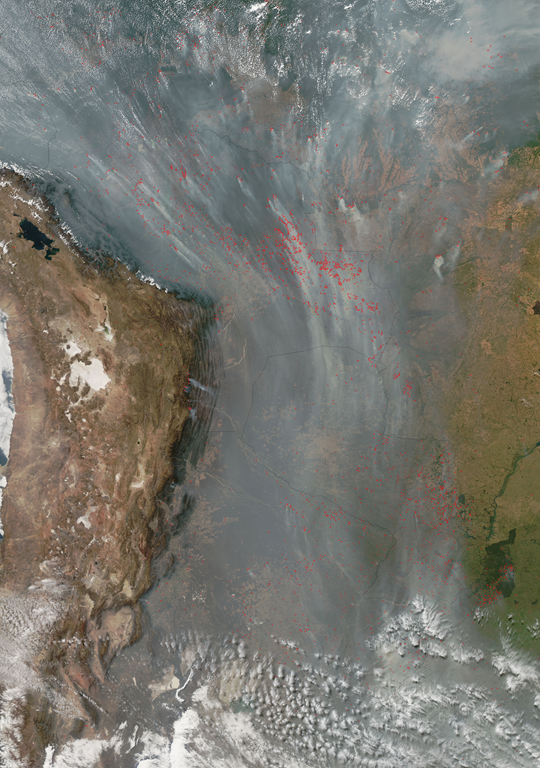Image of the Day: South America Forest Fires Viewed from Orbit, 1 September 2010
The Moderate Resolution Imaging Spectroradiometer (MODIS) on NASA’s Aqua satellite detected 148,946 fires in this image on August 23, 2010. The fires are outlined in red. Most of the fires are concentrated in Bolivia, where the governments of two states had declared a state of emergency because of widespread fires three days earlier. Scores of fires also burn in Brazil, Paraguay, and Argentina. The fires cloak the heart of South America in gray-white smoke. Spreading north and south along the east side of the Andes Mountains, the smoke extends over the entire 2,500-kilometer length of the image. The smoke closed 28 of Bolivia’s 39 airports, reported CNN on August 19. While some fires do occur naturally in Bolivia, most of these fires were probably set deliberately to clear land for crops or pasture. August is the height of the dry fire season in the region. In 2010, however, unusually dry weather and winds allowed many land management fires to expand into dangerous large wildfires. In Bolivia, the dry season comes in winter, and coincides with cold temperatures. The winter of 2010 has been exceptionally cold. Water temperatures in rivers that normally average 15°C (59° F) during the day fell to as low as 4° C (39° F). The cold waters have been linked to massive die-offs of many fresh-water species. On August 27, 2010, the journal Nature reported the loss of about six million fish and thousands of alligators, turtles and river dolphins. Cold can kill fish by reducing the oxygen content of water, as well as by direct effects on the physiology of fish, especially tropical species. Experts caution, however, that multiple causes, not just cold, likely play a role in die-offs as large and widespread as this one. Smoke can be a significant source of river pollution, and some scientists believe that the extreme fire season plays a role in this ecological disaster. Nature reports that studies are planned in this region to discover the multiple causes of the die-off.
September 1, 2010 – Fires and smoke in South America 
WWF
03 September 2010 Brasília, Brazil – High temperatures, low humidity and uncertainty over the future of forest laws are fuelling a boost in forest fires over much of Brazil. Overnight on August 30, satellite data collected by the National Institute of Space Researches (Instituto Nacional de Pesquisas Espaciais – INPE) showed 177 fire spots in central and central west Brazil and also in the north, south and south east of the country. The 45,860 forest fires recorded so far this year is nearly 50 per cent higher than from the equivalent January to August period in 2009, putting Brazil on track to exceed the fire totals for 2007, the highest in the last five years. While high temperatures – 30-35 degrees C in central Brazil – and humidity readings of under 20 per cent are undoubtedly contributing, Alberto Setzer, INPEs Forest Fire Monitoring coordinator, believes that the increase of fire occurrences this year is also related to the undefined future of the Brazilian Forest Code, which has been under severe attack by some sectors of the Brazilian Congress. The current forest-burning season will not figure on the next release of annual deforestation rates, but the intense degradation facilitates illegal deforestation. “Soon, many of these areas will no longer be forests,” Setzer said. “In fact, burning the forest is usually the first and cheapest step to clean out a forest area.” …
Big dry and legal doubts fuel progress to new forest burn boom in Brazil
